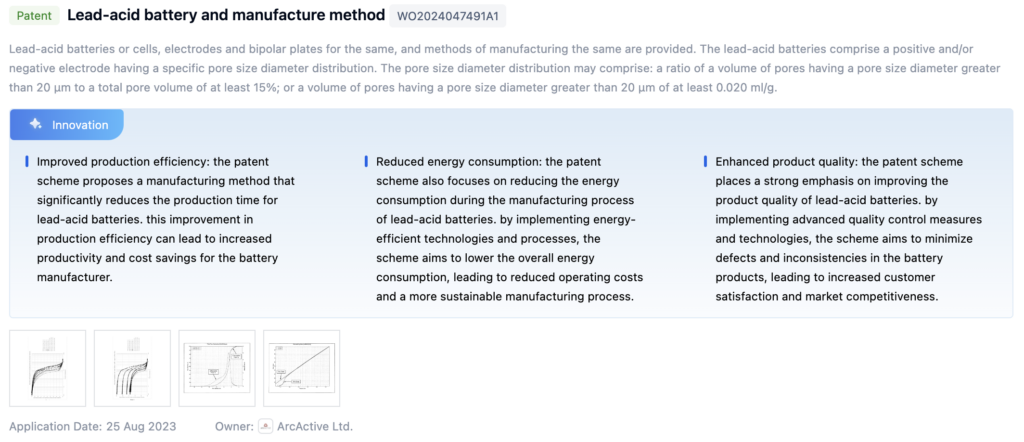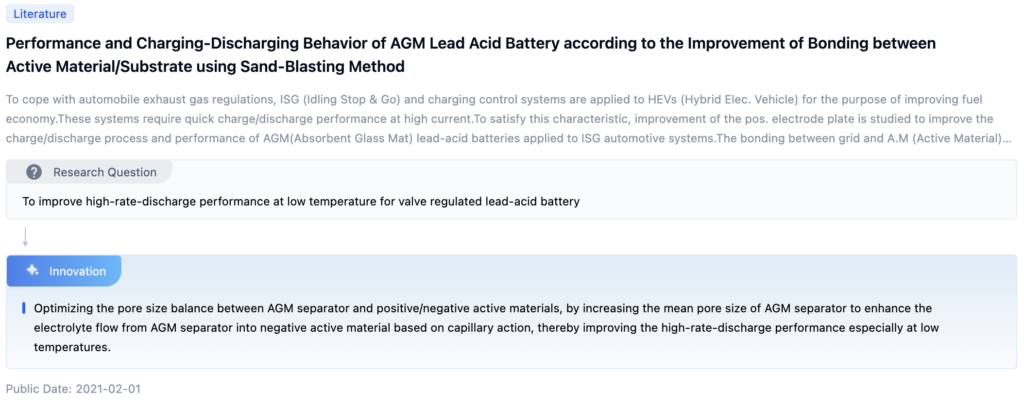
AGM Battery Technology Background and Goals
AGM (Absorbed Glass Mat) batteries, also known as valve-regulated lead-acid (VRLA) batteries, have been widely adopted in various applications due to their maintenance-free and leak-proof design. The consistency of AGM batteries is closely tied to their performance, reliability, and lifespan. Inconsistencies can arise from various factors, including variations in raw materials, manufacturing processes, and operating conditions. These inconsistencies can lead to uneven charge/discharge characteristics, premature capacity degradation, and potential safety issues.
Enhancing the consistency of AGM batteries is a multifaceted endeavor that requires a comprehensive understanding of the underlying electrochemical processes, material properties, and manufacturing techniques. Researchers and manufacturers have been exploring various strategies to address this challenge, including:
1. Optimizing raw material selection and quality control: Stringent quality control measures for lead alloys, electrolyte composition, and glass mat separators can minimize variations in material properties and ensure consistent performance.
2. Refining manufacturing processes: Advancements in electrode casting, curing, and assembly techniques can improve the uniformity of active material distribution, reduce internal resistance, and enhance overall battery consistency.
3. Developing advanced battery management systems (BMS): Intelligent BMS algorithms can monitor and adjust charging/discharging parameters, compensating for individual cell variations and prolonging battery life.
4. Exploring new materials and designs: Researchers are investigating alternative materials, such as carbon-based additives, advanced separators, and novel electrode structures, to enhance the consistency and performance of AGM batteries.
5. Implementing advanced characterization and modeling techniques: Sophisticated analytical tools and computational models can provide insights into the underlying mechanisms affecting battery consistency, enabling data-driven optimization and design improvements.
Achieving consistent and reliable AGM battery performance is crucial for ensuring the seamless operation of critical systems and promoting the widespread adoption of renewable energy technologies. Continuous research and innovation in materials, manufacturing processes, and battery management strategies are essential to overcome this challenge and unlock the full potential of AGM battery technology.

To get a detailed scientific explanations of agm battery, try Eureka.
Market Demand for Consistent AGM Batteries
The demand for consistent and reliable AGM batteries is increasing across various industries, driven by the need for uninterrupted power supply and energy storage solutions. AGM batteries offer advantages such as improved safety, low maintenance, and resistance to leakage and vibration.
Key industries driving demand include:
- Automotive: Used in start-stop systems for improved fuel efficiency and reduced emissions, and as a power source for auxiliary systems in electric and hybrid vehicles.
- Telecommunications: Provides backup power for telecom infrastructure, ensuring continuous operation during grid outages, especially important with the expansion of 5G networks.
- Renewable Energy: Essential for energy storage in solar and wind power installations, storing excess energy and providing power during low or no generation periods.
- Healthcare, Security, and Emergency Backup: Reliable and consistent battery performance is critical for life-saving equipment, security systems, and emergency response systems.
The demand is driven by the need for reliable and uninterrupted power supply, energy efficiency, sustainability, and the adoption of advanced technologies requiring high-performance energy storage solutions.
Current State and Challenges of AGM Batteries

Despite advancements, AGM batteries face challenges in consistency and performance:
- Consistency Across Conditions: Maintaining consistent performance over the battery’s lifespan is challenging, with factors such as temperature fluctuations, charging patterns, and depth of discharge impacting performance.
- Thermal Runaway and Safety: The maintenance-free, sealed design can lead to gas and pressure buildup, causing swelling, leakage, or explosions if not properly managed.
- Manufacturing Complexity: Precise control over the manufacturing process is required to avoid inconsistencies in battery performance and reliability.
- Regional Challenges: Geographic factors like climate conditions and usage patterns can affect consistency and lifespan, with regions experiencing extreme temperatures or high humidity being more affected.
Ongoing research focuses on improving materials, optimizing manufacturing processes, and developing advanced battery management systems to address these challenges.
Evolution of AGM Battery Technologies

Existing Solutions for AGM Battery Consistency
AGM Battery Grid Structure
Grid designs and materials are crucial for performance and durability. Innovations in grid structure and manufacturing aim to improve battery consistency and performance.
AGM Battery Separator and Integration
Separators prevent short circuits and ensure proper electrolyte distribution. Innovations in separator design, material composition, and manufacturing processes enhance battery reliability.
AGM Battery Assembly and Sealing
Proper assembly and sealing maintain battery integrity and performance, with advancements focusing on improving these processes.
AGM Battery Formation and Manufacturing Processes
Optimizing acid filling, drying, and assembly processes is essential for improving efficiency and quality in AGM battery manufacturing.
AGM Battery Testing and Quality Control
Methods for evaluating consistency and performance under different conditions ensure reliable and high-quality AGM batteries.
Key Players in AGM Battery Industry
Daramic LLC
Specializes in AGM battery separators, enhancing consistency through superior acid absorption and retention.
Samsung Electronics Co. Ltd.
Focuses on improving AGM battery consistency through advanced electrolyte formulations and separator materials.
Hubei Titanium Times New Energy Co. Ltd.
Innovates in manufacturing processes and material enhancements for better performance and reliability.
LG Energy Solution Ltd.
Uses high-purity lead and advanced grid designs to enhance cycle life and performance under various conditions.
Samsung SDI Co. Ltd.
Develops proprietary AGM battery technology with advanced additives to improve charge acceptance and reduce sulfation.
Core Innovations in AGM Battery Technology
Patent 1: Lead-Acid Battery and Manufacture Method
- Improved Production Efficiency: Reduces production time for lead-acid batteries, leading to increased productivity and cost savings.
- Reduced Energy Consumption: Focuses on energy-efficient technologies and processes, lowering overall energy consumption.
- Enhanced Product Quality: Emphasizes advanced quality control measures to minimize defects and inconsistencies.

Patent 2: Pressurizing System for Gas Turbine Power Station
- Efficient Energy Use: Recovers thermal energy from gas turbine exhaust for power generation or other uses.
- Improved Turbine Blade Cooling: Uses hollow blades and film cooling holes to extend turbine blade service life.

Paper 1: Performance and Charging-Discharging Behavior of AGM Lead-Acid Battery
- Optimizing Pore Size Balance: Enhances electrolyte flow to improve high-rate-discharge performance, especially at low temperatures.

Potential Breakthroughs in AGM Battery Consistency
AGM Battery Separator Structure and Materials
Innovations include multi-layer separators and composite materials to improve performance and reliability.
AGM Battery Formation and Acid Filling Processes
Developments in acid filling and formation processes ensure consistent quality and performance.
AGM Battery Grid and Electrode Structures
Innovations in grid designs and electrode structures enhance performance and consistency.
Consistency Evaluation and Screening Methods
Methods for evaluating and screening AGM batteries ensure consistent performance and quality.
Environmental Impact of AGM Batteries
Environmental considerations include proper disposal and recycling of lead and sulfuric acid to prevent contamination. The manufacturing process also impacts resource depletion, energy consumption, and emissions. Implementing circular economy principles and exploring alternative battery technologies can reduce the environmental footprint.
Regulatory Landscape for Battery Manufacturing
Regulations govern the production, transportation, and disposal of batteries, focusing on safety, environmental protection, and responsible resource management. Compliance with regulations such as the EU Battery Directive and U.S. EPA guidelines is crucial for sustainable battery production.
If you want an in-depth research or a technical report, you can always get what you want in Eureka Technical Research. Try now!

